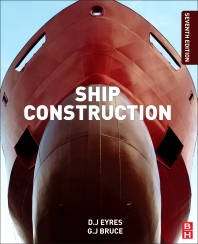LIMITED OFFER
Save 50% on book bundles
Immediately download your ebook while waiting for your print delivery. No promo code is needed.
Ship Construction, Seventh Edition, offers guidance for ship design and shipbuilding from start to finish. It provides an overview of current shipyard techniques, safety in shipya… Read more

LIMITED OFFER
Immediately download your ebook while waiting for your print delivery. No promo code is needed.
Preface
Acknowledgments
Part 1 Introduction to Shipbuilding
1. Basic design of the ship
Preparation of the design
Information provided by design
Purchase of a new vessel
Ship contracts
Further reading
Some useful websites
2. Ship dimensions, form, size, or category
Oil tankers
Bulk carriers
Container ships
IMO oil tanker categories
Panama canal limits
Suez canal limits
Some useful websites
3. Development of ship types
Dry cargo ships
Bulk carriers
Car carriers
Oil tankers
Passenger ships
Further reading
Part 2 Materials and Strength of Ships
4. Classification societies
Rules and regulations
Lloyd’s register
Classification of ships operating in ice
Structural design programs
Periodical surveys
Hull planned maintenance scheme
Damage repairs
Further reading
5. Steels
Manufacture of steels
Heat treatment of steels
Steel sections
Shipbuilding steels
High tensile steels
Corrosion-resistant steels
Steel sandwich panels
Steel castings
Steel forgings
Further reading
6. Other shipbuilding materials
Aluminum alloy
Production of aluminum
Aluminum alloy sandwich panels
Fire protection
Fiber-reinforced composites (FRCs)
Some useful websites
7. Testing of materials
Classification society tests for hull materials
8. Stresses to which a ship is subject
Vertical shear and longitudinal bending in still water
Bending moments in a seaway
Longitudinal shear forces
Bending stresses
Transverse stresses
Local stresses
Brittle fracture
Fatigue failures
Buckling
Monitoring ship stresses at sea
Further reading
Some useful websites
Part 3 Welding and Cutting
9. Welding and cutting processes used in shipbuilding
Gas welding
Electric arc welding
Other welding processes
Cutting processes
Further reading
10. Welding practice and testing welds
Welding practice
Welding automation
Welding distortion
Welding sequences
Testing welds
Nondestructive testing
Classification society weld tests
Further reading
Part 4 Shipyard Practice
11. Shipyard layout
Further reading
Some useful websites
12. Design information for production
Ship drawing office
Loftwork following drawing office
Computer-aided design (CAD)/computer-aided manufacturing (CAM)
Further reading
Some useful websites
13. Plate and section preparation and machining
Plate and section preparation
Plate and section part preparation
Frame bending
Further reading
Some useful websites
14. Assembly of ship structure
Assembly
Subassemblies
Unit assembly
Block assembly
Outfit modules
Unit erection
Joining ship sections afloat
Further reading
15. Launching
End launches
Side launches
Building docks
Ship lifts
Floating docks
Marine railways
Further reading
Some useful websites
Part 5 Ship Structure
Introduction
Introduction
Basic structural arrangements
Note
16. Bottom structure
Keels
Single-bottom structure
Double-bottom structure
Machinery seats
17. Shell plating and framing
Shell plating
Framing
Tank side brackets
Local strengthening of shell plating
Bilge keel
Further reading
Some useful websites
18. Bulkheads and pillars
Bulkheads
Watertight doors
Deep tanks
Topside tanks
Shaft tunnel
Pillars
Further reading
Some useful websites
19. Decks, hatches, and superstructures
Decks
Hatches
Bulwarks
Superstructures and deckhouses
Further reading
Some useful websites
20. Fore end structure
Stem
Bulbous bows
Chain locker
Hawse pipes
Bow steering arrangements
Bow thrust units
Some useful websites
21. Aft end structure
Stern construction
Stern frame
Rudders
Steering gear
Sterntube
Shaft bossing and ‘A’ brackets
Propellers
Electric podded propulsors
Further reading
22. Tanker construction
Oil tankers
Materials for tanker construction
Construction in tank spaces
Bulkheads
Hatchways
Testing tanks
Fore end structure
After end structure
Superstructures
Floating production, storage, and offloading vessels
Chemical tankers
Further reading
23. Liquefied gas carriers
Liquefied petroleum gas (LPG)
Liquefied natural gas (LNG)
The IMO international gas carrier code
Liquefied petroleum gas ships
Liquefied natural gas ships
General arrangement of gas carriers
Lloyd’s classification
Further reading
Some useful websites
Part 6 Outfit
24. Cargo lifting arrangements
Shipboard cranes
Masts and Sampson posts
Derrick rigs
Further reading
Some useful websites
25. Cargo access, handling, and restraint
Stern and bow doors
Ramps
Side doors and loaders
Portable decks
Scissors lift
Cargo restraint
Further reading
Some useful websites
26. Pumping and piping arrangements
Bilge and ballast pumping and piping
General service pipes and pumping
Air and sounding pipes
Sea inlets
Cargo pumping and piping arrangements in tankers
Further reading
Some useful websites
27. Corrosion control and antifouling systems
Nature and forms of corrosion
Corrosion control
Antifouling systems
Painting ships
Further reading
Some useful websites
28. Heating, ventilation, air-conditioning, refrigeration, and insulation
Ventilation
Refrigeration
Insulation
Refrigerated container ships
Further reading
Some useful websites
Part 7 International Regulations
29. International Maritime Organization
Organization of the IMO
Work of the IMO
Relationship with national authorities
Relationship with classification societies
Further reading
Some useful websites
30. Tonnage
International Convention on Tonnage Measurement of Ships 1969
Tonnages
Measurement
Compensated gross tonnage (CGT)
Further reading
31. Load Line Rules
Freeboard computation
Conditions of assignment of freeboard
Further reading
32. Structural fire protection
Requirements
‘A’, ‘B’, and ‘C’ class divisions
Openings in fire protection divisions
Protection of special category spaces
Fire protection arrangements in high-speed craft
Further reading
Some useful websites
Subject Index
GB
KH